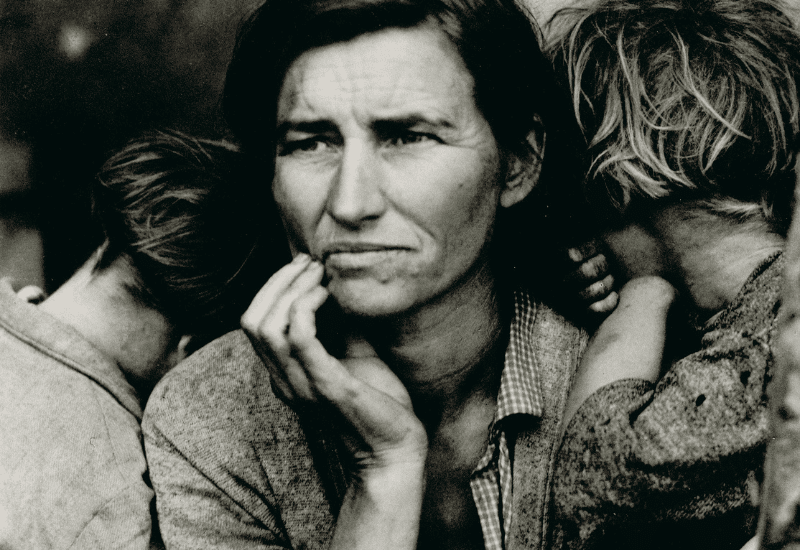Changing Views: The Photography of Dorothea Lange
By Bryan Corbin, Storyteller magazine editor, and Jessica Nelson, Ph.D., director of religion and culture initiatives

Dorothea Lange (1895-1965)
Migrant Mother, Nipomo, California, 1936
Gelatin silver print, 32 x 26 inches (framed)
art2art Circulating Exhibitions
The most iconic image of the Great Depression is Migrant Mother, a 1936 photograph of a family facing stark poverty. The mother is seen cradling her infant, her two older children burrowing their faces into her shoulders. Their tattered clothing and lean-to tent reflect the economic catastrophe that befell the family and many others. With worry lines etched into her weathered features, the mother’s weary expression conveys both desperation and determination as she gazes into the distance toward an uncertain future.
Migrant Mother created a national stir when it first was published in newspapers in 1936, and it has been reproduced innumerable times since. The black-and-white image is the best-known work of photographer Dorothea Lange, whose documentary photographs depicted people enduring the Depression and war years and captured their strength and humanity, creating a sense of empathy.
A traveling exhibition of 30 oversized prints of Lange’s original photographs is coming to the Eiteljorg Museum. Changing Views: The Photography of Dorothea Lange explores the work of Lange and her fellow documentary photographers in the 1930s to awaken the nation’s conscience to the plight of people across America uprooted by the Great Depression. Included are Lange’s portraits White Angel Breadline, Migratory Cotton Picker, Eloy, Arizona and Migrant Mother, among others. The exhibition also highlights a diverse array of four contemporary photographers whose compelling images make the case for social change. A Graflex camera similar to the one Lange used in the 1930s will be on view in the show.

Dorothea Lange, Resettlement Administration photographer, in California, 1936
Farm Security Administration – Office of War Information Photograph Collection (Library of Congress)
An unforgettable expression
Intrepid is one way to describe Dorothea Lange (1895-1965). A survivor of polio with limited mobility in one leg, Lange owned and operated a portrait photography studio in San Francisco in a field dominated by men. During her first marriage, to Western painter Maynard Dixon, Lange was the breadwinner, supporting her husband and their two children.
As the Great Depression deepened following the October 1929 stock market crash, millions were left unemployed by 1933. Committed to social justice, Lange turned her attention and camera lens to photograph those suffering. As her images gained fame, she was hired by the U.S. Resettlement Administration, later called the Farm Security Administration (FSA) — one of many New Deal agencies President Franklin Roosevelt created to tackle the emergency after he took office in 1933. Using techniques of photojournalism, Lange and other photographers from the agency fanned out across the country, photographing ordinary people to document their struggles with poverty.

Dorothea Lange (1895-1965)
White Angel Breadline, San Francisco, 1933
Gelatin silver print, 28 x 22 inches (framed)
art2art Circulating Exhibitions
Lange spent weeks at a time driving to assignments with her camera. As the government project was intended to build public support for greater intervention, the agency distributed the documentary photographs to newspapers — which in the 1930s were still (along with radio) the dominant way people got their news.
In March 1936, Lange was returning from such an assignment when she saw a roadside sign for a migrant worker camp near Nipomo, California. She initially passed it by, but turned around and stopped to photograph the camp. The pea crop that many migrant workers had hoped to pick had frozen, creating a desperate humanitarian situation. In the cold rain, Lange spotted a mother with a haggard expression and hungry children.
Focusing her Graflex camera, Lange made seven exposures of the 32-year-old woman and her children huddled in the tent. The mother’s name was not recorded in Lange’s notes, but Lange, a mother herself, promptly delivered the photographs to an editor at the San Francisco News. The final frame became the iconic Migrant Mother. Picked up by wire services and published in newspapers nationwide, the photograph created a public outcry demanding assistance for the Nipomo migrant camp — although by the time help arrived, the family in the photo had moved on.
Lange did not immediately become famous for the image, but her photographs for the government agency, published widely, served to shape public opinion and policies in Washington DC.
The Depression lingered until the start of World War II. After the attack on Pearl Harbor in 1941, Lange gave up a prestigious Guggenheim Fellowship to go on assignment documenting the forced removal of Japanese Americans on the West Coast. Once again, she was hired by a government agency — the War Relocation Authority (WRA), which had absorbed the FSA — but this time, she subverted the agency’s goals. Instead of promoting Japanese internment camps, her poignant photographs show the resiliency and dignity of Japanese Americans and the injustice of their incarceration. Because of this, Lange’s photographs were not widely publicized by the WRA. Changing Views offers an in-depth look at several of these previously censored images.

Dorothea Lange (1895-1965)
Pledge of Allegiance, Raphael Weill Elementary School, San Francisco, April 20, 1942
The J. Paul Getty Museum, Los Angeles. 2000.50.16
Beyond Lange
It wasn’t until after Lange’s death in 1965 that she was fully recognized as a major figure in documentary photography. But her influence lives on in powerful images of the human condition taken by documentarians, photojournalists and amateur photographers alike, using still cameras, film and video cameras, and now digital video on smartphones. From news photographers’ shots of civil rights protests in the 1960s to an eyewitness’ video of the murder of George Floyd in 2020, images that force viewers to confront difficult realities and understand common humanity are often catalysts for social change.
An innovator in documentary photography, Lange was part of an emerging cohort of photographers, including several who also were hired by the FSA. Members of this group crisscrossed the nation to record the human and social costs of the Great Depression, especially in rural areas. Changing Views features more than two dozen photographs from FSA photographers such as Walker Evans, Arthur Rothstein and Marion Post Walcott (the only other female photographer hired by the FSA), as well as photographers who did not work for the FSA but used a similar approach in their work, such as Doris Ulmann and Indiana-born Mike Disfarmer. They used the equipment available — bulky cameras and cumbersome flash units — to capture glimpses of the surrounding world.
Contemporary photographers have continued to be inspired by Lange’s approach, and also used new technology and new perspectives to innovate. Changing Views highlights the work of four modern-day photographers and the ways they share images of the world around them. In contrast to Lange’s time, almost everyone today has easy access to a camera, and can take a quick snapshot or record a video at a moment’s notice. The photographers included in this exhibition — based in Oregon, California, New York, Texas and Indiana — celebrate broader access to photography as an art form and medium of communication. They also offer guidance for the ethics of documentary photography — particularly in the ways that they feel connection with, and responsibility to, the individuals and communities featured in their images. From Nīa MacKnight’s intimate looks at the experiences of urban Indigenous mothers and Mary Inhea Kang’s record of refugee communities, to Josué Rivas’ and Wildstyle Paschall’s images of recent protests, these artists offer fresh takes on the ways that the dignity and perseverance of the human spirit can appear in a photograph. They encourage viewers to consider how their own perspective on the people around them, when shared in an image, might change the world.
A timeless image
The identity of the woman in Migrant Mother was not widely known until 1978, when a newspaper reporter for The Modesto Bee tracked down a retiree in her 70s named Florence Owens Thompson in a mobile home park and confirmed she was the mother. By this time living in more stable circumstances, Thompson reportedly was not pleased that the extreme poverty she and her children had endured as migrants in 1936 became subject of one of the world’s most famous and widely reprinted photographs; after all, Thompson (like Lange) had not received payment for it. But Lange’s photograph was so well recognized that, when Thompson later lay dying in a hospital in 1983, Thompson’s adult children made a public appeal for assistance for the woman who had been the Migrant Mother; and in an early form of crowdfunding, thousands of dollars in donations were raised for Thompson’s medical expenses and burial, according to media reports at the time.
The Migrant Mother image has since appeared on a U.S. postage stamp and in many books and films, and Dorothea Lange’s legacy as one of America’s greatest documentary photographers is secure. Eiteljorg visitors can experience the iconic photograph in person, along with other examples of Lange’s work during Changing Views: The Photography of Dorothea Lange, which runs from March 4 to Aug. 6. They can also see photography from Lange’s Great Depression-era peers as well as by contemporary photographers.
The exhibition also includes photography by Herron School of Art + Design students, and opportunities for the public to share their own photographs on the subject of social change and participate in public programs related to the show. Several engaging public programs are planned to coincide with Changing Views; see https://eiteljorg.org/events/ for details.

Dorothea Lange (1895-1965), Girl with mattress springs, California, 1935
Gelatin silver print, 18 x 14 inches (framed)
art2art Circulating Exhibitions
CHANGING VIEWS: THE PHOTOGRAPHY OF DOROTHEA LANGE
MAR 4-AUG 6, 2023
Eiteljorg Museum, Special Exhibitions Gallery
All works are from the collection of Michael Mattis and Judith Hochberg.
This exhibition was organized by art2art Circulating Exhibitions.
Presented by:
Capital Group
Avis Foundation, Inc.
With additional support from:
Roberts Camera
#ChangingViews
Books about Dorothea Lange are available in the Frank and Katrina Basile Museum Store at the Eiteljorg.
Editor’s Note: This article originally appeared in the February 2023 issue of Storyteller magazine









